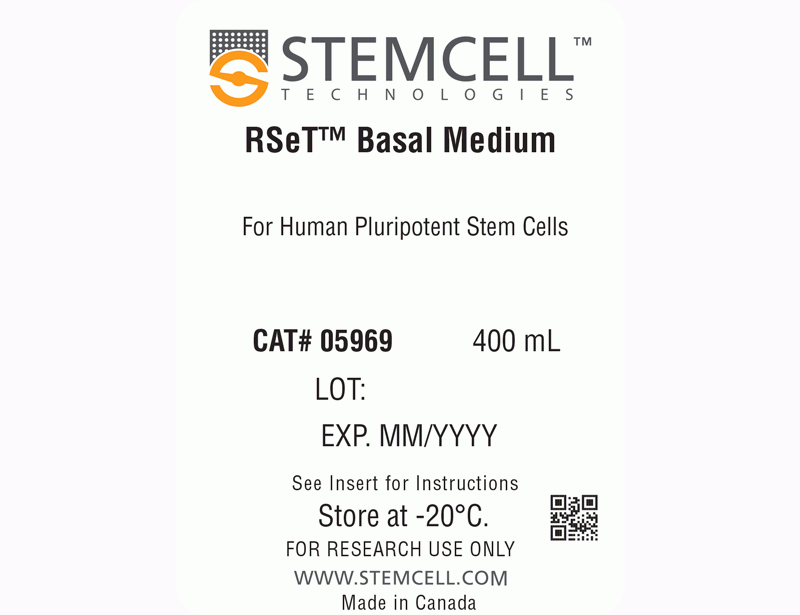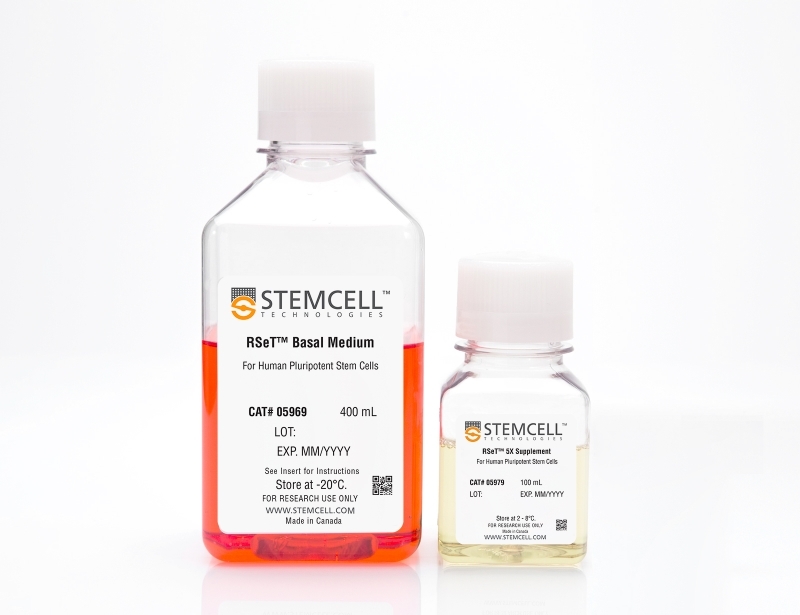RSeT™ Medium (2-component)
hPSCs cultured in RSeT™ Medium exhibit features of a naïve-like state such as tightly packed, domed colonies with refractive edges. Key transcripts associated with naïve-like hPSCs such as KLF2, KLF4, and TFCP2L1 show increased expression in hPSCs cultured in RSeT™ Medium. RSeT™ hPSCs can be converted back to a primed state by culture in mTeSR™1 and can then be differentiated with STEMdiff™ products such as STEMdiff™ Definitive Endoderm Kit (Catalog #05110), STEMdiff™ SMADi Neural Induction Kit (Catalog #08581), and STEMdiff™ Mesoderm Induction Medium (Catalog #05220).
• Maintains naïve-like pluripotency without bFGF or TGFβ
• Defined medium contains pre-screened quality components for reproducible results
• No exogenous genes required for reversion to naïve-like state
- RSeT™ Basal Medium, 400 mL
- RSeT™ 5X Supplement, 100 mL
| Document Type | 产品名称 | Catalog # | Lot # | 语言 |
|---|---|---|---|---|
| Product Information Sheet | RSeT™ Medium (2-Component) | 05978 | All | English |
| Manual | RSeT™ Medium (2-component) | 05978 | All | English |
| Safety Data Sheet 1 | RSeT™ Medium (2-Component) | 05978 | All | English |
| Safety Data Sheet 2 | RSeT™ Medium (2-Component) | 05978 | All | English |
Data

Figure 1. Schematic of Reversion of Primed to Naïve-Like hPSCs
Primed hPSCs are plated as aggregates in mTeSR™1 onto irradiated mouse embryonic fibroblasts (iMEFs). On day 1, mTeSR™1 is replaced with RSeT™, and the medium is exchanged daily. By day 5 or 6, the colonies are generally large enough to be passaged. During the initial culture in RSeT™ medium, colonies expand and begin to adopt domed shape characteristic of naïve-like stem cells and can continue to be propagated in RSeT™.

Figure 2. ES and iPS Cells Can Be Reverted to a Naïve-Like State
Representative images of human (A) ES cells (H1) and (B) iPS cells (STiPS-F016) lines that reverted to a naïve-like state after cultured in RSeT™ for 6 and 10 passages, respectively. (C) During reversion, colonies change from a flat morphology to a domed morphology characteristic of naïve-state hPSCs. Once naïve-like cultures are established, typically > 80% of colonies have a dome-shaped morphology.

Figure 3. ES and iPS Cells Can Be Converted Back into a Primed State
Representative images of human ES cells (H1) cultured in (A) RSeT™ for 3 passages and then (B) reconverted into a primed state in mTeSR™1 for 5 days.

Figure 4. hPSCs Maintained in RSeT™ Express High Levels of Factors Associated with Naïve-Like PSCs
Expression of markers associated with naïve-like PSCs (DNMT3L, KLF17, KLF2, KLF4, NANOG, TBX3, and TCFP2L1) in (A) WLS-1C and (B) STiPS-F019 iPS cells that were reverted back to a naïve-like state after culturing in RSeT™. Expression levels were measured by quantitative PCR (qPCR) and normalized to levels in primed STiPS-F019 iPS cells.

Figure 5. hPSCs Maintained in RSeT™ Display Normal Karyotype after Long-Term Passaging
Representative karyograms of (A) ES cells (H1) and (B) iPS cells (WLS-1C) lines that were cultured in RSeT™ medium for 14 and 15 passages, respectively.



